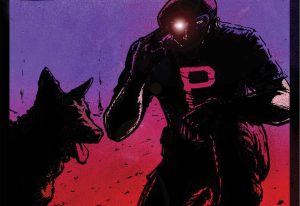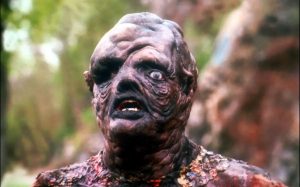
Review: Doctor Who – The Comic Strip Companion / Author: Paul Scoones / Publisher: Telos Books / Release Date: Out Now
Fact: Doctor Who has been around longer as a comic strip than as a TV show. Doctor Who, as you may be aware, debuted on BBC1 in November 1963 and finished its original run in December 1989, disappearing from the screens (bar one TV movie in May 1996) until 2005; the comic strip based on the show made its first appearance in November 1964 in Polystyle’s long-runing TV Comic and, apart from a few months in 1979 when the strip was preparing to move to its new home in Marvel’s Doctor Who Weekly, has been running ever since in some form or another. New Zealander Paul Scoones’ extraordinarily dense new book, a real doorstopper (if you were so inclined), chronicles not only the comic strip stories themselves but also the origins and development of the scripts courtesy of behind-the-scenes snippets, comments from writers and artists and contemporary contributions from the BBC who were more involved with the progress of the strip than might ever have been imagined.
Most of the 1960s Doctor Who strips were primitive and childish affairs – no criticism as that’s exactly the audience they were created for. With Polystyle’s budget stretching only to the likeness of William Hartnell’s Doctor the comic was forced to create two new companion characters – the Doctor’s “grandchildren” John and Gillian – and for several years the trio wandered throughout Time and Space becoming involved in simple, rather silly stories featuring Dalek-replacement robots the Trods, many of the yarns consisting of painfully straight-forward capture-escape scenarios which the Doctor often resolved courtesy of some uncharacteristic act of comic strip violence. Later in the 1960s Polystyle were able to use the Daleks and, with Patrick Troughton playing the role on TV, stronger links were forged to the series with the appearance of long-time travelling companion Jamie and regular appearances by both the Cybermen and the Quarks. It was only when the third Doctor’s comic strip adventures moved across to the lavish, glossy Countdown comic (possibly the slickest comic ever produced in the UK) that the strip really found its feet and became much more sophisticated. Few young 1970s Who fans will forget Countdown (and later its cheaper successor TV Action) and Gerry Haylock’s beautifully illustrated stories, often written by comic editor Dennis Hooper. The 1970s strips boasted much more intelligent and imaginative science-fiction storylines which perfectly captured Pertwee’s characterisation of the Doctor if, again for contractual reasons, unable to replicate the TV series’ story format and supporting characters. By 1973 TV Action too had folded, collapsing back into the original TV Comic where Doctor Who remained until 1979 and artist John Canning, who took over in 1977, adopting a broader, more cartoonish style even though the strip maintained a sort of continuity with the TV show by the inclusion of Sarah Jane and Leela accompanying the Doctor as they were on TV. In 1978 the ‘original’ comic strip came to an end and for a few months TV Comic reprinted old Pertwee strips with a likeness of Tom Baker clumsily replacing that of his predecessor.
Scoones’ book is a hugely impressive piece of work but possibly not a ‘sit down and read’ type of book. It’s very much a ‘dip in and sample’ tome and you’ll most likely gravitate towards the era of comics you grew up with – that’ll be the Pertwees for this reviewer – and the level of detail as to how the strips and stories came about is almost bewildering. But it’s a big ol’ read – there are no real illustrations from the strips beyond an eight-page centre spread of all the comic covers featuring the series (and the Doctor Who Annuals, Dalek Annuals and Dalek strips from the classic 1960s TV21 are all detailed in the book) – and very much one for the completist rather than the casual new fan who might be developing a vague interest in the history of the show. The Comic Strip Companion is an extraordinary and impressive, if slightly dry, piece of work and it finally provides an exhaustive analysis of a rather large piece of Doctor Who history which has gone unrecorded for far too long.








No comment yet, add your voice below!